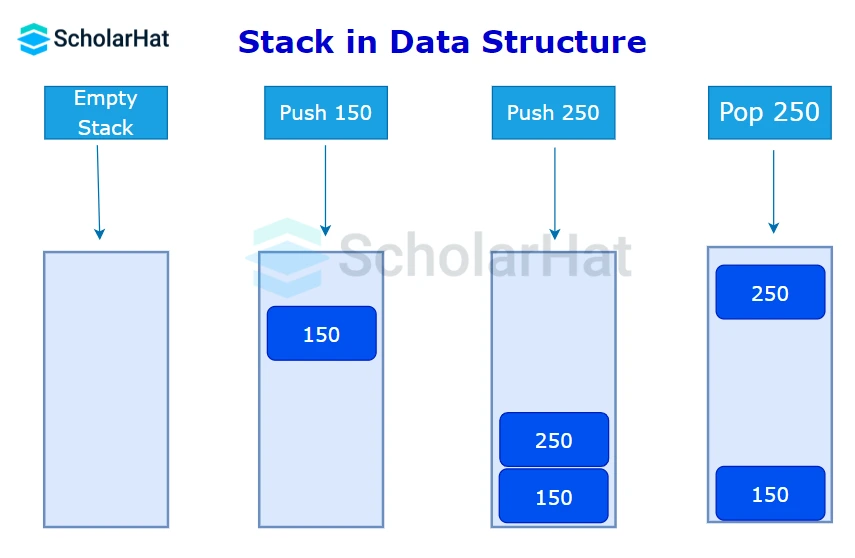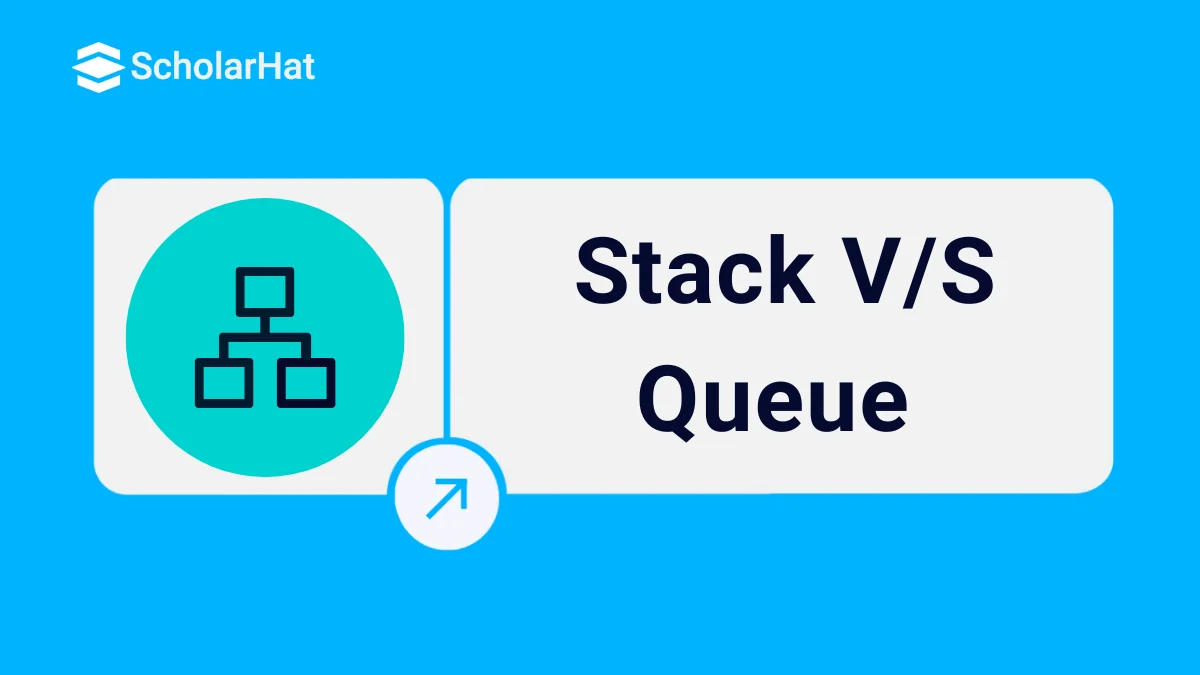08
JanDifferences Between Stack and Queue Data Structures
Stack Vs. Queue
Stack and Queue are the types of non-primitive linear data structures. In a stack, you can add or remove elements only from one end called the top. In the case of a queue, there are two ends, REAR and FRONT for insertion and deletion respectively.
In this DSA tutorial, we'll analyze the differences between stacks and queues in data structures. To further enhance your understanding of data structures, enroll in our best DSA Course Free.
What is Stack?
A stack is an ordered list or we can say a container in which insertion and deletion can be done from the one end known as the top of the stack. The last inserted element is available first and is the first one to be deleted. Hence, it is known as Last In, First Out LIFO, or First In, Last Out FILO.
In a stack, the element at the top is known as the top element. When a new element is added to the stack, it is placed on top of the existing elements. Stacks are dynamic; i.e they do not have a fixed size and their size can be increased or decreased depending on the number of elements

Operations of a Stack
- push(): The push() operation is one of the fundamental operations in a stack data structure. It means inserting an element at the top of the stack. If the stack is full, it is said to be an Overflow condition.
- pop(): The pop() operation removes the topmost element of the stack and returns its value. This operation modifies the state of the stack by removing the topmost element. The items are popped in the reversed order in which they are pushed. If the Stack is empty, it is an Underflow condition.
- peek(): The peek() operation returns the value of the topmost element of the stack without modifying the stack.
- isFull(): The isFull() operation determines if the stack is full. A stack is said to be full if it has reached its maximum capacity and there is no more space to add new elements to the stack.
- isEmpty(): The isEmpty() operation is used to check if the stack is empty or not. It returns a boolean value, true when the stack is empty, otherwise false.
Read More: Stack Data Structures
What is Queue?
A queue is an ordered list in which insertion is done at one end called REAR and deletion at another end called FRONT. The first inserted element is available first for the operations to be performed and is the first one to be deleted. Hence, it is known as First In First Out, FIFO, or Last In Last Out, LILO.

Operations of a Queue
- enqueue(): The enqueue() operation is used to insert an element at the back of a queue, to the end of a queue, or the rear end of the queue.
- dequeue(): The dequeue() operation removes and returns the element from the front of a queue.
- peek(): The peek() operation returns the value at the front end of the queue without removing it.
- isFull(): The isFull() operation determines if the queue is full. A queue is said to be full if it has reached its maximum capacity and there is no more space to add new elements to it.
- isEmpty(): The isEmpty() operation is used to check if the queue is empty or not. It returns a boolean value, true when the queue is empty, otherwise false.
Read More: Queue in Data Structures
How Stacks and Queues are Similar?
- Linear Data Structure: Both stacks and queues come in the category of linear data structure i.e. data in these data structures is arranged in a sequence, one after the other i.e. each element appears to be connected linearly.
- Implementation: Both of them can be implemented using arrays and linked lists.
- Flexible in Size: Both stack and queue are flexible in size i.e. they can grow and shrink as per the requirements at the run-time.
- Concurrency: Stacks and queues are used in concurrent programming and parallel computing to manage tasks and data access.
Stacks Vs. Queues: A Thorough Comparison
| Parameters | Stack | Queue |
| Working Principle | It follows the | It follows the |
| Pointers | It has only one end, known as the | It has two ends, |
| Operations | The insertion operation is known as | The insertion operation is known as |
| Empty Condition | The condition for checking whether the stack is empty is | The condition for checking whether the queue is empty is |
| Full Condition | The condition for checking if the stack is full is | The condition for checking if the queue is full is |
| Variants | There are no other variants or types of the stack. | There are three types of queues: |
| Implementation | It has a simple implementation compared to queues as no two pointers are involved. | It has a complex implementation compared to stacks as two pointers |
| Data Representation | Often implemented with | Can also be implemented with |
| Example | the Undo/Redo operation in Word or Excel. | operating system process scheduling queues. |
| Application | It is used to solve | It is used to solve sequential processing-based problems. |
| Visualization | A stack can be visualized as a vertical collection. | Queue can be visualized as a horizontal collection. |
Summary
I hope that you are now clear on the differentiating factors between the two most popular data structures: stacks and queues. We know the wide applications of both data structures in real-time applications. So, you must be thorough with all the underlying concepts of these two data structures. To deepen your understanding and enhance your skills, consider enrolling in our DSA Online Course Free With Certificate, which provides structured learning and certification to help you excel in data structures and algorithms.
Only 2% of Java Developers become Solution Architects. Don’t get left behind—Enroll now in our Java Architect Certification and secure your career growth & 60% higher salary potential.
FAQs
- push()
- pop()
- peek()
- isFull()
- isEmpty()
- enqueue()
- dequeue()
- peek()
- isFull()
- isEmpty()
- Real world analogies for stack are: stack of pates, books, call stack, etc.
- Real world analogies for queue are: students standing in a line for prayer, print queue, etc.
Take our Datastructures skill challenge to evaluate yourself!

In less than 5 minutes, with our skill challenge, you can identify your knowledge gaps and strengths in a given skill.












